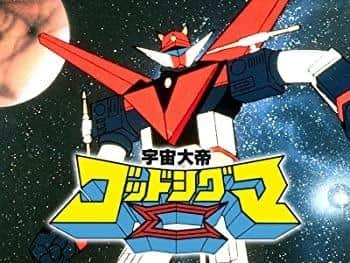The appeal and evaluation of Space Emperor God Sigma: A monumental achievement in robot anime

Space Emperor God Sigma - Space Emperor God Sigma■ Public MediaTV anime series ■ Original MediaAnime Original ■ Broadcast periodMarch 19, 1980 - March 25, 1981 Every Wednesday 19:30 - 20:00 ■Broadcasting stationTokyo 12 Channel ■Frequencieshalf an hour ■ Number of EpisodesEpisode 50 ■Original StoryYatsude Saburo ■ ProductionTokyo 12 Channel, Toei, Toei Agency ■ StoryIn the year 2050, humanity has made great strides in space development technology and has begun to migrate to extraterrestrial terrestrial planets. However, a mysterious enemy, the Elder Army, suddenly appears and attacks, occupying Jupiter's moon Io, the destination of their migration. The Elder Army attacks Trinity City to steal the Trinity Energy, which has the power of several dozen times that of a hydrogen bomb. To protect the Earth and the Trinity Energy, Dan Toshiya and his friends pilot the giant robot God Sigma and engage in a fierce battle with the Elder Army. ■ExplanationThis robot anime is set mainly on Jupiter, not Earth. The rings of Jupiter were discovered the year before the show aired, so the Jupiter that appears in the ending video also has rings. The enemy came from the future, which was a novel setting for the time, and the truth behind this was revealed midway through the story, which caused quite a stir. ■Cast・Dan Toshiya/Toyama Kei/Julie Noguchi/Yasuhara Yoshito/Kira Kensaku/Genda Tesshō/Dr. Kazami/Tomita Kousei/Commander Teral/Ohara Noriko/Kasuga Rie/Takizawa Kumiko/Gagaan/Terashima Mikio ■ Main staff・Original story: Saburo Yatsude ・Serial: Terebi-kun, TV Land ・Producers: Heita Gotsu (Tokyo 12 Channel), Takashi Iijima, Itaru Orita (Toei Television Business Division) ■ Main Characters A hot-blooded man with exceptional athletic ability and judgment. When he was caught up in an attack by the Elder Army in Trinity City, he boarded the Sky Thunder King and threw himself into the fight. ■SubtitleEpisode 1: Rage, Io's Warriors Episode 2: Trinity Base Takes Off Episode 3: Combining for Io Episode 4: The Secret of the Cosmosaurus Episode 5: The Shrew Rescue Mission Episode 6: The Little Intruder Episode 7: Head to the Moon Episode 8: The Great Naughty Mission Episode 9: The Survivor from Io Episode 10: As a Father, As a Doctor Episode 11: The Little Lover in Danger Episode 12: The Enemy Eldar Planet Discovered Episode 13 /Io's flower blooms・Episode 14/Angry showdown・Episode 15/Dangerous present・Episode 16/The secret of the enemy commander Terral・Episode 17/The buyer of the giant robot・Episode 18/The terrifying combination breaks down・Episode 19/The robot cannot launch・Episode 20/Julie's secret savings・Episode 21/Break the meteorite encirclement・Episode 22/The Sky Thunder King does not return・Episode 23/I saw a phantom fish・Episode 24/200 km to Io・Episode 25/The base Earth Movement Order・Episode 26/The Cute Rebel・Episode 27/The Enemy of 2300・Episode 28/The Prelude to a New Battle・Episode 29/See the White Flag of Earth・Episode 30/Full of Danger・Episode 31/Latest News on Io・Episode 32/The Duel for the Moon・Episode 33/The Stadium of Hell・Episode 34/The Tears of the Enemy Commander Teral・Episode 35/The Day of Teral's Execution・Episode 36/My Julie's Sister・Episode 37/The Secret of 2300・Episode Episode 38: Departure for IoEpisode 39: Who is the traitorEpisode 40: Deadly MarsEpisode 41: Birthday is a funeral dayEpisode 42: Rebellion on MarsEpisode 43: Pick up Teral's bonesEpisode 44: Io has disappearedEpisode 45: FightingIo's EarthlingsEpisode 46: Madness's declaration of defeatEpisode 47: Dr. Kazami's rebellionEpisode 48: Standing on Io's soilEpisode 49: Gravestone on IoEpisode 50: Departure to the future Space Emperor God Sigma - Uchuutaitei God Sigma Review and RecommendationOne of the most memorable robot anime from the 1980s, "Space Emperor God Sigma" has captivated many fans with its unique setting and story development. The story is set in an extraterrestrial setting, providing viewers with a new perspective and a charm that goes beyond the boundaries of robot anime at the time. Below, we will explain in detail the appeal and characteristics of this work, as well as the recommended points. The appeal of the storyThe story of "Space Emperor God Sigma" is set in the future, in the year 2050. In an era when humanity has advanced in space development technology and begun to migrate outside of Earth, a mysterious enemy called the Elder Army suddenly appears and occupies Jupiter's moon Io, attempting to steal the Trinity Energy. This Trinity Energy is an energy with the potential power dozens of times that of a hydrogen bomb, and the story revolves around Dan Toshiya and his friends riding the giant robot God Sigma to fight the Elder Army in order to prevent it from being seized. The appeal of this story lies in its setting. By setting the main stage on Jupiter instead of Earth, viewers can sense the new expanse of the universe. Also, the premise that the Eldar army comes from the future was novel at the time, and the truth of this becoming clear from the middle of the story onwards caused quite a stir. This kind of setting provides viewers with a new perspective, adding depth to the story. Character AppealThe characters of "Space Emperor God Sigma" are also an important element that enhances the appeal of the work. The main character, Toshiya Dan, is a hot-blooded man with outstanding athletic ability and judgment, who throws himself into the battle after being caught up in an attack by the Elder Army in Trinity City. His bravery and leadership leave a strong impression on viewers. Julie Noguchi is the chief engineer of Trinity City and a highly qualified pilot. Her technical skills and courage are important elements that add excitement to the story. Furthermore, Kira Kensaku is Toshiya's best friend, and his presence, nicknamed "Kiraken," also adds depth to the story. Dr. Kazami is the developer of Trinity Energy and God Sigma, and initially is passionate about his mission to protect the Earth, but his attitude changes as he tries to protect the Trinity Energy data. His struggles and growth move viewers. And Commander-in-Chief Teral of the Elder Army is the commander dispatched to Earth to seize the Trinity Energy, and is a kind-hearted character who dislikes conflict. His humanity and struggles also add depth to the story. The charm of mechanicsThe mechanical design of "Space Emperor God Sigma" is also an important element that enhances the appeal of the work. God Sigma is a giant robot that is completed by combining the three bodies, Kuraioh, Kaimeioh, and Rikushinoh, with Big Wing, and exerts tremendous power using Trinity Energy as its power source. The design of this combined robot leaves a strong impression on viewers and can be said to be the symbol of the work. In addition, the design of the submarine by Katsuji Murakami, who was in charge of the mechanical design, was highly praised among robot anime at the time, and offered viewers a new perspective. In particular, the God Sigma fusion scene left a strong impression on viewers, and is an important element that enhances the appeal of the work. The appeal of musicThe music of "Space Emperor God Sigma" is also an important element that enhances the appeal of the work. The opening theme "Ganbare! Uchuu no Senshi" leaves a strong impression on viewers with its powerful voices sung by Sasaki Isao, Koorogi'73, and Columbia Yurikago-kai, and is a symbol of the work. The ending theme "Red, Blue, Yellow" features gentle voices sung by Kaori Kumiko, Koorogi'73, and Columbia Yurikago-kai that move viewers and are an important element that enhances the appeal of the work. Furthermore, the background music by Hiroshi Tsutsui, who was in charge of the music, is also an important element that enhances the appeal of the work. His music has a strong impact on the viewer and plays an important role in exciting the development of the story. In particular, the background music in God Sigma's fusion scene and battle scene leaves a strong impression on the viewer and is an important element that enhances the appeal of the work. Recommended points"Space Emperor God Sigma" is a work that leaves a strong impression on viewers with its unique setting and story development, the charm of the characters, the mechanical design, the appeal of the music, and many other elements. In particular, by being set in an extraterrestrial setting, it offers viewers a new perspective and has an appeal that goes beyond the boundaries of robot anime at the time. This work is recommended not only for robot anime fans, but also for viewers who like science fiction and action. It is also recommended for viewers who want to know the history of robot anime in the 1980s. It is also recommended for viewers who are interested in music and mechanical design. "Space Emperor God Sigma" is a work that attracts many viewers with its unique charm, so we recommend that you watch it at least once. Further information and supplementary information"Space Emperor God Sigma" was broadcast on Tokyo 12 Channel from March 19, 1980 to March 25, 1981 every Wednesday from 7:30 to 8:00 p.m. It is a series of 50 episodes, each 30 minutes long. It was written by Yatsude Saburo and produced by Tokyo 12 Channel, Toei, and Toei Agency. The series is an original anime, and was serialized on TV-kun and TV Land. It was produced by Gotsu Heita (Tokyo 12 Channel), Iijima Kei, and Orita Itaru (Toei Television Business Division), and the music was by Tsutsui Hiroshi. The performances were done by the Tokyo Chamber Music Association, and the chief directors were Kanda Takeyuki (episodes 1-10) and Taguchi Katsuhiko (episodes 11-50). Character design was by Udagawa Kazuhiko, character drafts by Shintani Kaoru, design assistance by Izubuchi Yutaka, mechanic design by Murakami Katsuji and Submarine, art direction by Okada Kazuo and Shimokawa Tadami, and sound direction by Kawamura Tsunehira. Animation was produced by Green Box, Anime City, and Sunlook, with production cooperation from Academy Productions → Tokyo Animation. The opening theme "Ganbare! Uchuu no Senshi" (Go for it! Space Warrior) was written by Saburo Yatsude, composed by Asei Kobayashi, arranged by Masahisa Takeichi, and sung by Isao Sasaki, Korogi'73, and Columbia Yurikagokai. The ending theme "Red, Blue, Yellow" was written by Saburo Yatsude, composed by Asei Kobayashi, arranged by Masahisa Takeichi, and sung by Miko Kaori, Korogi'73, and Columbia Yurikagokai. "Space Emperor God Sigma" is a work that leaves a strong impression on viewers with its unique setting and story development, the charm of the characters, the mechanical design, the appeal of the music, and many other elements. In particular, by focusing on an extraterrestrial setting, it offers viewers a new perspective and has an appeal that goes beyond the boundaries of robot anime at the time. This work is recommended not only for robot anime fans, but also for viewers who like science fiction and action. It is also recommended for viewers who want to know the history of robot anime in the 1980s. It is also recommended for viewers who are interested in music and mechanical design. "Space Emperor God Sigma" is a work that attracts many viewers with its unique charm, and we highly recommend that you give it a watch. |
<<: Astro Boy's Earth Defense Force: Appeal and evaluation of episode 4 and the second movie
Recommend
The trailer for the game-adapted movie "Until Dawn" will be released on April 25
Today (January 17), the trailer for the game-adap...
All the main actors are present! The grand promotional event of "Terminator: Dark Fate" in Japan
The classic sci-fi blockbuster "Terminator: ...
The Conjuring 4: The Final Chapter of the Conjuring Series is set to be released on September 5, 2025
The Conjuring film series created by James Wan is...
"Don't mess with the image research!" TV animation special promotional video animator storyboard appears
The dark horse manga "Don't Mess with th...
The appeal and evaluation of "Marx Radio": A deep review
"MarxRadio": A perfect mix of comedy an...
"Super Mouseman" review: Entertainment that exceeds expectations
Super Mouseman - Butterfly Mouseman overview &quo...
The new female lead of the TV series "Mr. and Mrs. Smith" is confirmed to be Asian + black
Recently, according to foreign media Variety, the...
Marvel won't use digital technology to bring Stan Lee back to the MCU
Marvel's Stan Lee has been dead for more than...
The appeal and reviews of "Mamotte! Lollipop": What is the new appeal of magical girl anime?
"Mamotte! Lollipop" - A magical pop sto...
HBO's new drama "Nothing To Do" officially released trailer starring Nicole Kidman and Hugh Grant
The official trailer for HBO's psychological ...
New stills of the movie "The Outer Man" starring Haruma Miura are released and will be released on December 11
The film "The Outer Man" starring the l...
Sonic the Hedgehog movie new Chinese trailer to stop the evil doctor's plan
Recently, Paramount Pictures released the Chinese...
"Monday's plumpness" Ai-chan's hand-made figure appreciates the black silk uniform short skirt super temptation
Ai-chan, a high school girl in "Monday's...
The Riddler actor in The Batman claims DC installed tracking devices to prevent script leaks
Movie studios go to great lengths to prevent stor...
Holland talks about the future of the Spider-Man series and says nothing is certain at the moment
The huge box office success of Spider-Man: No Hom...









